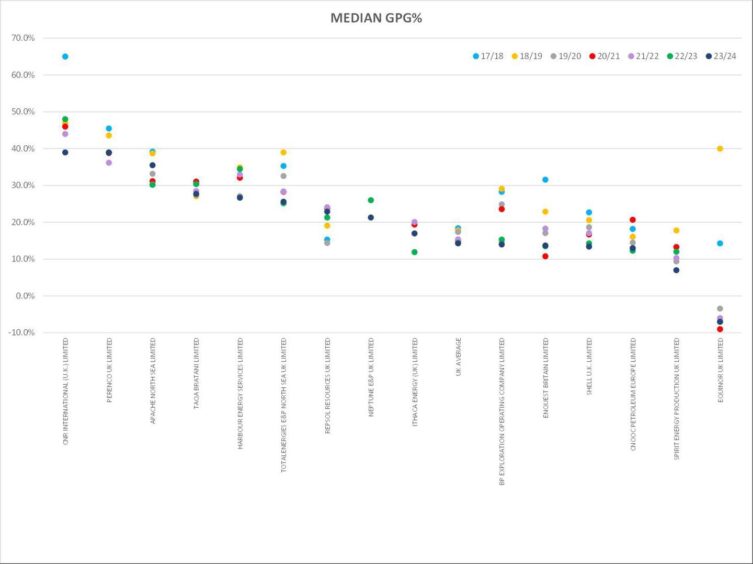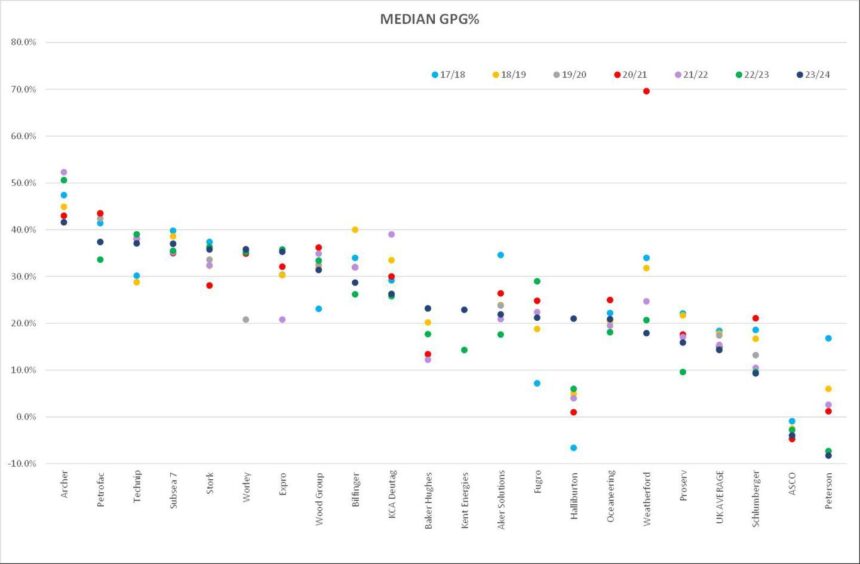
Women working for operators make 79p for every pound a man makes, and that figure drops to 76p for supply chain workers, gender equality group AXIS Network has revealed.
Aberdeen’s AXIS has shared that in the six years since gender pay gap reporting became mandatory in the UK progress in the sector has been “too slow” with 10.8% gained by operators and as little as 1.3% by service companies.
CNR International was shown to be the operator with the largest disparity in pay between men and women, with Perenco being found to be not much better.
It’s worth noting that CNR has seen “the greatest single improvement during the seven years” out of the firms reported.
A Perenco spokesperson said in response to the AXIS findings: “Perenco has successfully (and considerably) narrowed its Gender Pay Gap over the last five years, through the continued identification and promotion of women across all business areas and careers.
“This has been achieved despite the headwinds the whole sector faces, in attracting women into STEM careers, and the energy sector more specifically.
“We are committed to providing equality of opportunity to those who seek an exciting, challenging, and rewarding career in the energy sector.”
The gender pay gap has dropped by 26% since first reported and now the disparity sits at 39% in the latest report.
Archer held that title for supply chain businesses with Petrofac, Technip and Subsea 7 being found to have roughly the same levels of disparity.
All of the firms listed above were contacted for comment.
Repsol’s difference in median pay between men and women has grown from 15.3% in 2017 to a disparity of 22.9% in 2023.
A spokeswoman for Repsol UK said: “The pay gap between men and women decreased between April 2022 and April 2023, a further improvement to the reduction in the previous year; attributed to a higher increase in salaries in the female population.
“Conversely the median of the Gender Pay Gap has grown. This due to the number of males in the higher salary band increasing while the number of women at the same level stayed the same.”
As the UK business is entirely owned by Repsol following the end of a dispute that saw Sinopec walk away from what was previously known as Repsol Sinopec Resources UK, Repsol believes it can address some of these issues going forward.
“As we integrate into the global organisation, we will have opportunities to identify new strategies to address our gender pay gap,” the spokesperson added.
However, Equinor has been found to have a negative gender pay gap with women receiving £1.07 for every pound a man earns.
On average, for supply chain firms there has been little change in gender pay gap reporting.
Initial figures showed a difference in pay of 25.5% and the most up-to-date figures show a 24.2% disparity, showing a change of just over 1% among suppliers.
However, ASCO and Peterson have also reached an inverse gender pay gap with the firms both showing that on average women are paid more than men.
SLB, ASCO and Paterson were the only supply chain firms with a gender pay gap below the UK average while Spirit Energy and Equinor were the only operators with a gender pay gap below 10%.
The gender equality group gathered data from the firms that have signed up to the AXIS Pledge.
Oil firms ‘are not going at the required pace’ to meet gender pay gap targets
The latest figures reveal that the industry is lagging behind the UK average wage discrepancy between men and women which stands at 91p for every £1 paid.
The firm argues that the Energy sector is “falling behind” the United Nations target of gender equality by 2030.
AXIS Network quantifies the gender pay gap as the median gross hourly earnings for all employees.
This means that the equality group is not comparing like-for-like roles but rather the overall average difference in pay for men and women across the sector.
With this in mind, AXIS’ analysis shows that men in the sector are seeing more success in securing higher-paying positions within organisations.
AXIS Network co-chair Emma Behjat said: “Although our analysis showed there were some really positive improvements within some organisations, and it was great to see that positive improvement correlate with being a Pledge signatory, overall the analysis tells us that we are not going at the required pace to meet the UN development goals.
“We need to learn from those who have had significant success so we can all move forward faster, together.”
Trade body sees ‘virtually no change’ in gender pay gap
In 2018 trade body Oil and Gas UK (now Offshore Energies UK) reported that the UK North Sea oil industry is not expected to reach gender parity until the 2050s.
Last year Offshore Energies UK (OEUK) said that the gender pay gap has seen “virtually no change” since its last report.
In 2023 it was found that 21% of energy companies across the UK have no female representation on their board of directors.
In POWERful Women’s Annual State of the Nation report it was found that at the top executive level, women make up just 16% of the roles.
Women are not just being underrepresented in the board room, Alix Thom, former workforce engagement and skills manager for OEUK, previously said that female representation offshore remains “stubbornly static.”
The figure has remained at around 3.4 – 3.6% of the offshore workforce, OEUK told Energy Voice at the time.
AXIS co-chair Sarah Clark added: “It’s great to see improvements within the data we have sampled, particularly those organisations who benefit from being an AXIS pledge signatory, but more can be done within the UK energy sector.
“The lack of pace indicates we’re not focusing on systemic change that benefits everyone, not just women.
“I would like to see us as a sector focus on fewer activities that prioritise shifting the dial, learning from each other in a more collaborative approach.”
Recommended for you



